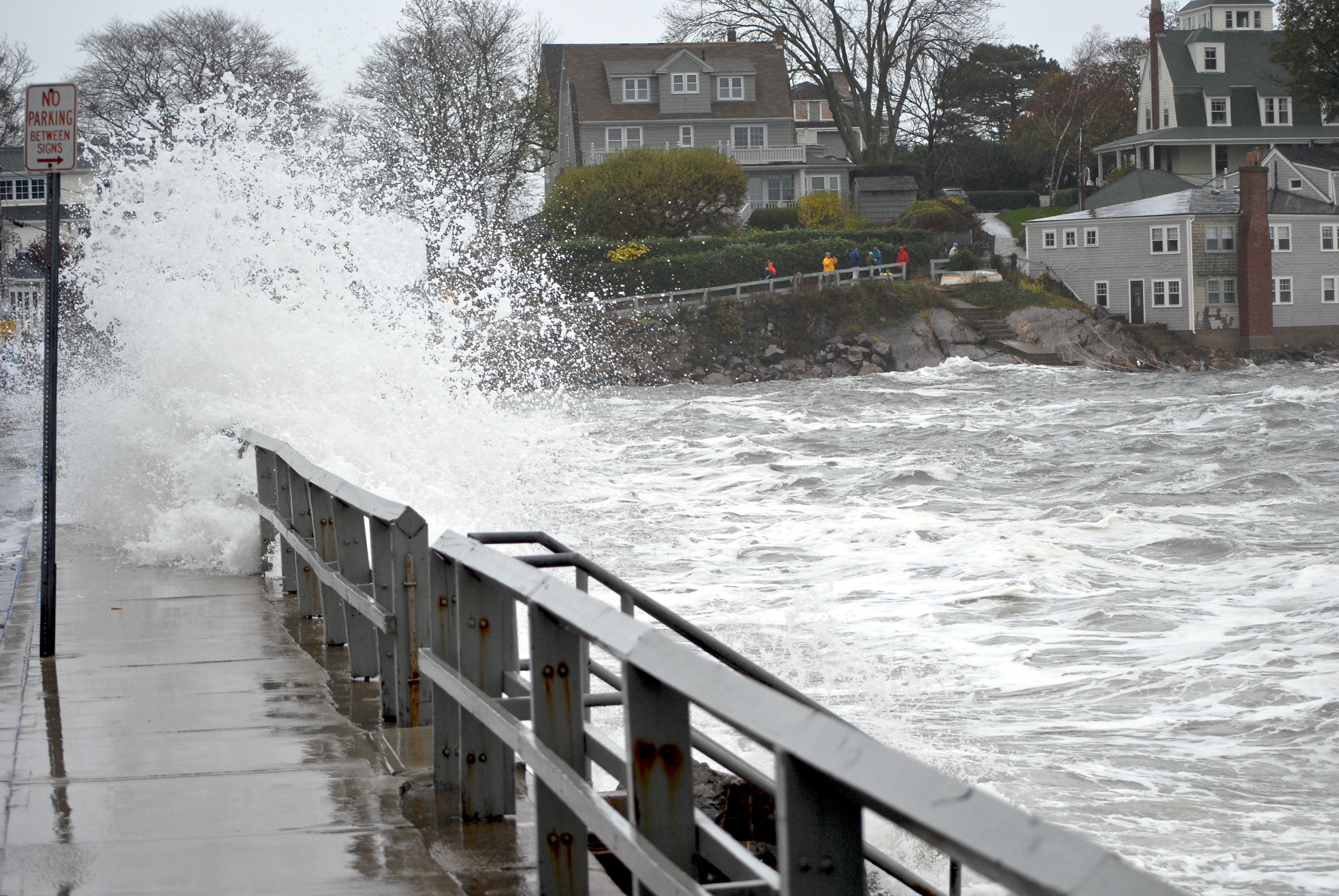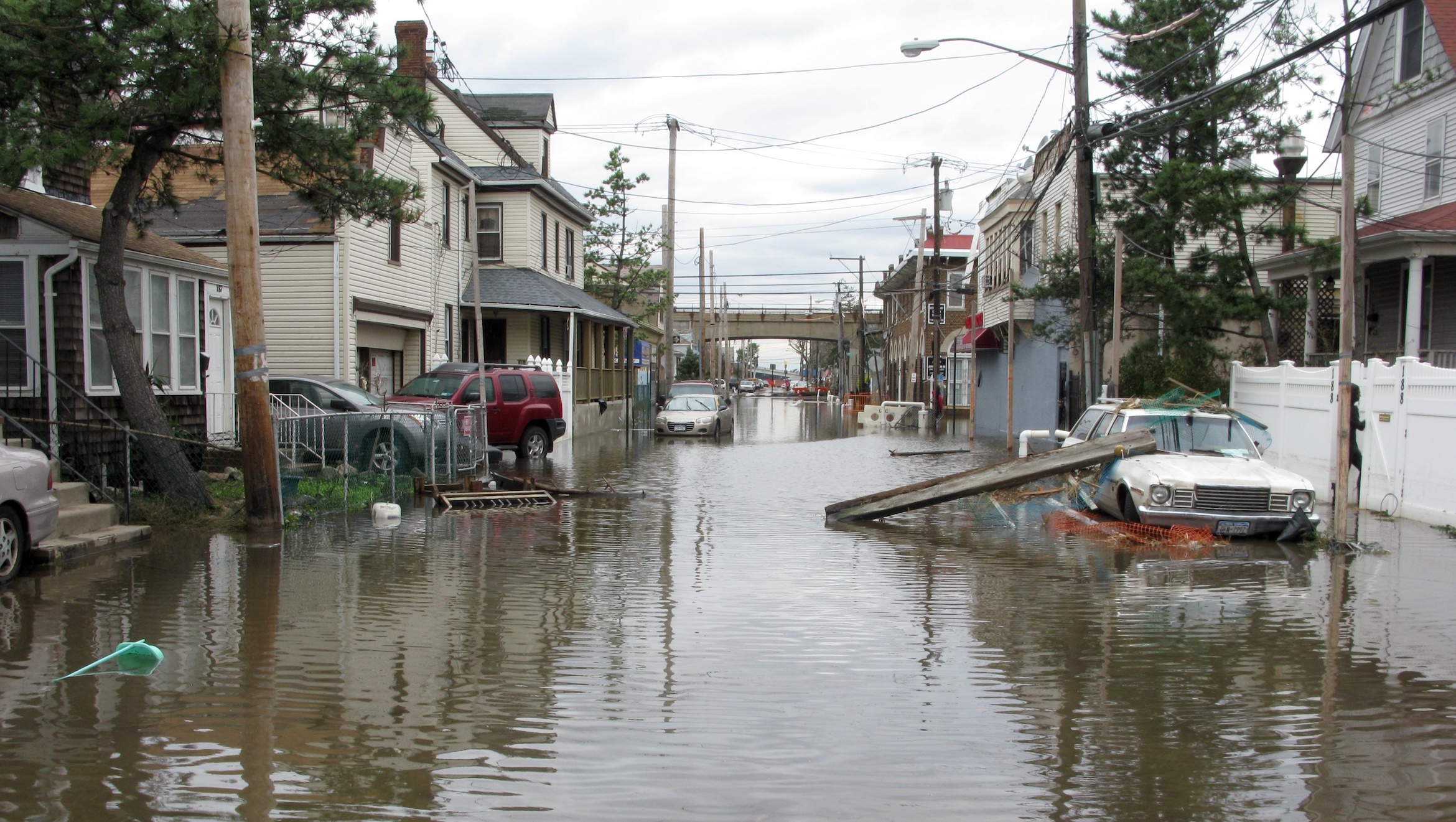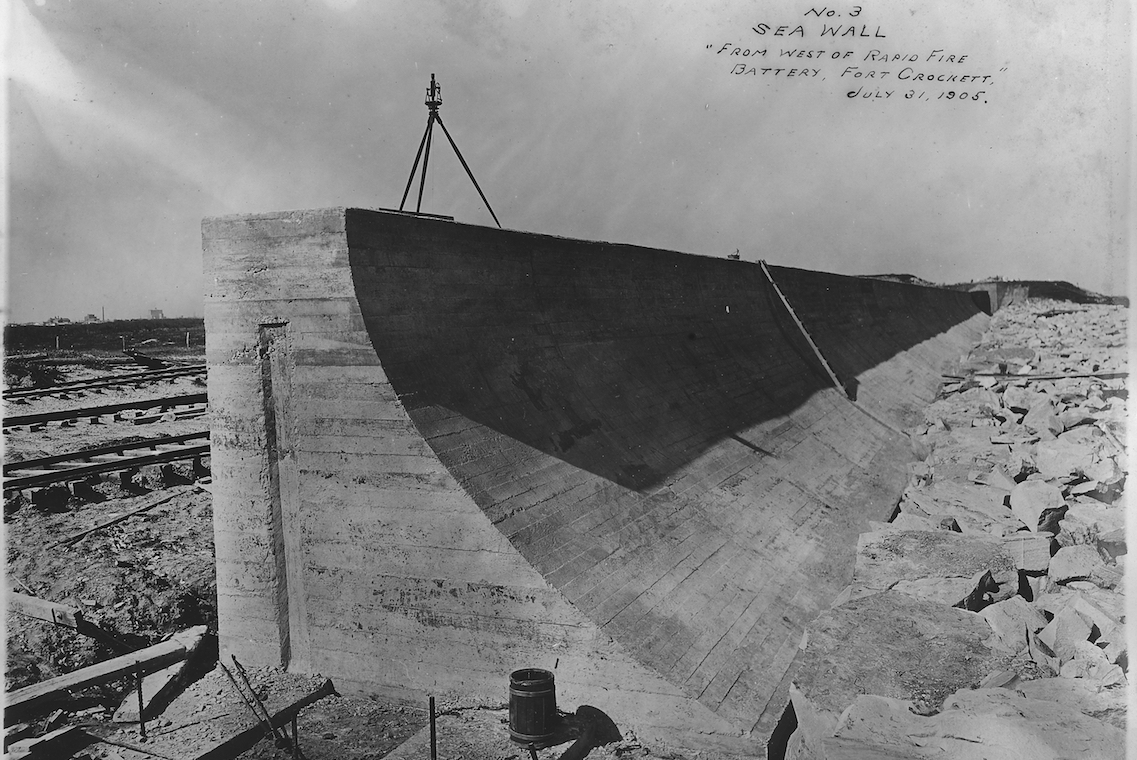
We are celebrating 15 years — and counting — of stories that are deeply researched and deeply felt, that build a historical record of what the city has been.
We are celebrating 15 years — and counting — of stories that are deeply researched and deeply felt, that build a historical record of what the city has been.
We associate inflatable structures with ludic landscapes like the bounce castle and hippie hangout. Impractical technoutopias all. But for engineer Sigrid Adriaenssens and her Form Finding Lab, inflatables could offer a very practical response to the growing threat of storm surge flooding and the uncertainty of climate change. More air bag than pleasure dome, inflatable sea walls could be an affordable and flexible solution to protect coastal cities from rising tides. Adriaenssens and her collaborator Steven Strauss make the case below. Whether building a sea wall or replacing a neighborhood with a swale, soft and hard infrastructures both come with high costs and take a long time to put in place. Ready in three years and deployable in three hours, inflatable rubber barriers present a different direction for life on the water.
At this point, there’s no question: Climate change is real, and it’s happening now. Sixteen of the seventeen warmest years on record have occurred since the turn of the 21st century; 2016 was the warmest year in recorded human history. Manmade greenhouse gas emissions will continue to drive further increases in global average temperatures.
However, the nature of the science is such that while the question of “whether” climate change is under way appears settled, the question of “what” this change will produce has a broader range of potential answers. We may already be experiencing global warming’s effect on polar ice and sea levels. Since 1979, the planet as a whole has lost an average of 13,500 square miles of sea ice per year — an area larger than the state of Maryland. Rising global temperatures will result in the melting of the polar ice caps, which cause a rise in average sea levels worldwide. This poses a particular problem when high winds from tropical storms and hurricanes drive water onto the land, creating “storm surge” tides.
Coastal cities face an increased risk of flooding as sea level rise is exacerbated by a possible increase in storm activity in some regions. But traditional responses to the risk of coastal flooding in dense cities all carry enormous — even prohibitive — financial, social, and environmental costs. At the Form Finding Lab at Princeton University, we are pursuing infrastructural solutions to the advancing risk of coastal flooding that are flexible, adaptable, and economical. Rather than heavy structures with great mass, we focus on coastal defense strategies that use lightweight forms whose most basic design principles account for the uncertainty of the future.
Even within an increased risk of coastal flooding due to climate change, there is a range of possible futures — computer simulations generate projections with some variance, and not all locations will suffer the exact same consequences. For instance, one optimistic scenario suggests a global average temperature rise of one degree Celsius between 2046 and 2065, followed by another one degree Celsius increase between 2081 and 2100.[1] Such a global temperature increase could yield minimum sea level rises of 1.7 to 2.4 feet by 2100, and it is expected that high severity flooding events will become more frequent. Many of the world’s leading cities are in coastal areas, and consequently will have significant exposure to climate change (including, for example: Miami, Guangzhou, Calcutta, Shanghai, and Mumbai).[2] But again, each city’s future is likely to look different, and New York City’s challenges are particularly acute. In New York City, recent research suggests that the frequency of a severe hurricane could rise from once in every 400 years, to once in every 23 years.[3] Four out of New York’s five boroughs are on islands, giving the city an unusually long waterfront of 520 miles. This makes it particularly vulnerable both to rising sea levels and to flooding from storms (as was painfully apparent after Superstorm Sandy).
Further, some parts of New York are especially vulnerable. The Rockaways, a slender peninsula with the Atlantic Ocean to the South and Jamaica Bay to the North, is home to over 100,000 people. Almost 400,000 New Yorkers live in the 100-year floodplain, at a higher population density than in any other US city facing a similar risk.
Of course, an area’s vulnerability is a consequence of multiple factors, including its initial height above sea level and general physical characteristics, the expected increase in average sea levels, the increase in frequency of severe storms, the increase in maximum expected height of storm surges, and the steps that have already been taken to mitigate the risk. The Rockaway peninsula, surrounded on three sides by water, is likely to be highly vulnerable compared to the Bronx (which is on the mainland and somewhat sheltered by the other boroughs as well as Long Island). Assuming for the moment that, with sufficient notice, significant loss of life can be avoided through evacuation and directing residents to take shelter, the property damage from a storm in a densely populated unprotected area would still be massive. Superstorm Sandy alone was estimated to have wrought $19 billion in damage, largely concentrated in select low-lying areas.
Given the likelihood of increasingly frequent and severe storm surges, in addition to rising temperatures and sea levels, the buildings and residents of low-lying neighborhoods along New York City’s waterfront may soon find themselves regularly under attack by the water that surrounds them. Conventionally, coastal cities have confronted this type of risk by building various types of massive fixed sea walls or barriers. These physical, “hard” barriers could include both coastal armoring structures built along the shoreline, like the seawalls of Sea Bright and Monmouth Beach, New Jersey, or shoreline stabilization structures like breakwaters, such as those in Alamitos, California, which can be off-shore or shore-connected.[4]
But such “armored” barriers carry high initial construction and maintenance costs, and the long project horizons characteristic of many large capital building projects. The US Army Corps of Engineers has estimated that building conventional coastal barriers to protect just the Rockaways would cost $4 billion, and that work, even if approved and funded, would not commence until 2020. A system of traditional surge barriers to protect all five boroughs would cost an estimated $20 to $25 billion and might take 20 to 30 years to design, approve, and build. Beyond the price tag of such projects, their environmental footprint alone could be prohibitive.[5] Hard coastal barriers block the water flow in a floodplain, which can lead to the depletion of plant populations and inhibit animal migration. In New York City, the environmental effects of such infrastructure are unknown but would likely be substantial, and would require extensive review before any project would be approved.
The difficulties of building traditional coastal barriers have triggered research into “soft and natural” coastal barriers to protect property, economic activity, and human life. Non-infrastructure approaches such as rezoning would depopulate vulnerable areas. Nurturing beach ecosystems like seagrass beds, dunes, mangrove forests, and marshes could then buffer coastal areas by attenuating and dissipating wave surges and wind damage caused by periodic storms.
However, over the last decades, 50 percent of salt marshes, 35 percent of mangroves, 30 percent of coral reefs, and 29 percent of seagrasses worldwide have already been lost or destroyed due to coastal development, population growth, pollution, and other activities.[6] Restoring these environments to the point of effectiveness as a bio-shield against storm surges requires a long-term strategic plan and coordinated population displacement that, in densely populated cities like New York, borders on impractical. While bio-shield strategies could be a component of a total solution, alone they are likely inadequate to the threats posed by climate change.
Finally, changes to the existing built environment by adaptation or accommodation, such as putting all houses on stilts, may also be possible in some areas. But to broadly mandate the elevation of existing buildings in densely populated urban floodplains would again pose significant practical problems.
As coastal cities prepare for global climate change, it appears options are limited: expensive and monumental barriers may mar the horizon and environment out at sea, while ecological or building-level solutions may displace and disrupt residents’ lives on land. Either type of solution seems to imply climate change will radically alter coastal areas. Under the usual paradigms, wherever Rockaways residents were to look, 100 years from now, they would be confronted with the knowledge that climate change had the power to utterly overturn their lives.
The permanence of hard barriers derives from the tradition of creating strength through material mass — structures that meet nigh-unstoppable forces with more or less immovable objects, like the reinforced concrete seawalls shown above. By contrast, at the Form Finding Lab, we are interested in structures that derive their strength from non-traditional materials and responsive shapes, dictated by the flow of potentially destructive forces. We develop numerical algorithms and design methodologies to identify these shapes, which improve the relationship between form and efficiency in sustainable and resilient urban structures. In this way, we can design innovative force‐modeled structural systems such as lightweight hoop-tensegrity and polyester rope footbridges, flexible adaptive architectural facades, and earthquake-resistant thin shell structures. These forms can be very thin, cost‐effective, and have a low carbon footprint, while maintaining strength and stability. They can also be more beautiful than the ominous, imposing mass of hard structures.
To the challenge of more frequent and more severe storm surges as a result of climate change, our answer is a storable, pressurized, flexible barrier that could be deployed along the coastline should the need arise. Colloquially known as “inflatable seawalls,” these systems are more economical compared to hard coastal structures. The material of the barrier is reinforced rubber, engineered to be durable and to resist the impact of ozone and ultraviolet light — and relatively easy to install and maintain. As a result, the construction and maintenance cost of pneumatic barriers is estimated to be about 75 percent less than that of equivalent rigid traditional seawalls.[7] In addition, the rubber material has a lifetime of 20 to 30 years, which actually constitutes a great advantage over hard, permanent coastal barriers: The inflatable barrier’s design, replacement, and construction can be rethought every so often to accommodate future changes in storm surge behavior. For example, if climate change is more severe compared to what is expected (remember, we are dealing with a range of possibilities) it is easier to modify the inflatable barrier to provide more protection, such as inflating the barriers to higher maximum heights. By contrast, a physical concrete sea wall would probably need to be totally demolished and rebuilt.
While this application of pressurized flexible systems is novel, they have already been successfully used in various engineering applications, from more familiar technologies like parachutes and air bags, to underwater compressed air energy storage, small scale hydraulic dams, and large span roof enclosures such as the pneumatic roof cover over the historic Roman arena in Nîmes, France.[8] But all previous applications (except for air bags) have been designed to bear slowly applied, constant force, rather than the continual battery of ocean waves. What’s more, all other existing applications of this type of pneumatic technology operate at a scale much smaller than that needed for storm surge barriers. So it is important to keep in mind that the proposed inflatable seawalls, while a natural evolution of the existing technologies, also newly applies those technologies to an especially complex situation.
A pressurized flexible barrier is essentially a flexible closed tube, filled with air or water that creates enough pressure to stand up to assault by storm surge and breaking waves. When deployed, it can change shape extensively while remaining functional. As the wave strikes the pneumatic barrier, the barrier can deform to absorb some of the kinetic energy. It will not break, overflow, or vibrate too much, as it blocks the storm surge, diverting it to the side and back to the ocean.
The barrier would be resistant to ozone and ultraviolet light, and able to withstand debris impact from the storm surge, like boats or flotsam, that might be driven into the barrier at high speeds. It would be relatively easy to install and maintain.
Initially the barrier would be folded, stowed, and clamped to a foundation — beneath a boardwalk, for example. In the event of a reported approaching storm surge, the barrier could be deployed in a matter of two to three hours. Once inflated, it would be monitored, and its pressure adjusted wirelessly, either by an operator or automatically, to adapt to changing conditions. In its inflated state, the clamped barrier would form a watertight seal with the concrete base foundation. Since by design it would be submerged under the boardwalk or surface and would not obstruct animal migration paths, the concrete base would not pose the same ecological problems as a hard sea barrier.
We have had some success with computer modeling, but a lack of existing research about the effect of real and future projected storm surge and wind on membranes of this sort means that a physical test of the technology, in the form of a pilot project, is necessary. We will carry out physical tests on small scale models of the barriers in 2018. These tests, simulating storm surge conditions in a wave tank, could validate our computer findings and provide data to improve the numerical model.
Following physical testing and improvements to the numerical model, the next stage will be a pilot test under actual coastal conditions. Time is of the essence: Existing, traditional solutions like concrete seawalls have so many inadequacies and drawbacks as to render them unviable in many situations. Absent a radical alternative, citizens of many of the world’s great coastal cities may find themselves forced to abandon waterfront neighborhoods en masse. Funding and technology permitting, we hope to be able to begin construction on a pilot in 2020; we believe that potential disaster, like encroaching tides, can be averted. No monolithic seawall need mar the horizon, and no improbable expanse of grasses and trees need displace the existing ecosystem. New Yorkers could face the ocean and rest easy in the knowledge that, no matter what waves and winds future storms might bring, the protection they need is waiting just beneath the surface.
It is important to note that these are all projections, based on simulations, and that estimates vary considerably (depending on the simulation, as well as whether it represents best case or worst case scenario, assumptions about future amelioration, etcetera).
Hanson, Susan, Robert Nicholls, N. Ranger, S. Hallegatte, J. Corfee-Morlot, C. Herweijer, and J. Chateau. “A Global Ranking of Port Cities with High Exposure to Climate Extremes.” Climatic Change, 104, no. 1 (January 1, 2011): 89–111. doi:10.1007/s10584-010-9977-4.
Lin, Ning, Robert E. Kopp, Benjamin P. Horton, and Jeffrey P. Donnelly. “Hurricane Sandy’s Flood Frequency Increasing from Year 1800 to 2100.” Proceedings of the National Academy of Sciences of the United States of America 113, no. 43 (October 25, 2016): 12071–75. doi:10.1073/pnas.1604386113).
K. Harada and F. Imamure, “Experimental Study on the Effect in Reducing Tsunami by Coastal Permeable Structures,” in The Twelfth International Offshore and Polar Engineering Conference, Kitahyusha, 2002. ; E. Barbier “Marine Ecosystem Services,” Current Biology, vol. 27, no. 11, pp. 507-510, 2017.
See for example Dugan, J. E., Hubbard, D. M., Rodil, I. F., Revell, D. L. and Schroeter, S. (2008), Ecological effects of coastal armoring on sandy beaches. Marine Ecology, 29: 160–170. doi:10.1111/j.1439-0485.2008.00231.x or Kraus, Nicholas C., and William G. McDougal. “The Effects of Seawalls on the Beach: Part I, An Updated Literature Review.” Journal of Coastal Research, vol. 12, no. 3, 1996, pp. 691–701. JSTOR, JSTOR, www.jstor.org/stable/4298517.
E. Barbier, “Marine ecosystem services,” Current Biology, vol. 27, no. 11, pp. 507-510, 2017.
M. Van Breukelen, “MSc. These Improvement and scale enlargement of the inflatable rubber barrier concpet,” TU Delft, Delft, 2013.
2014. Snyder, J. Sitter and J. Chung, “Design and Testing of an Airbag System for High-Mass, High-Velocity Deceleration,” Journal of Dynamic Systems, Measurement and Control, vol. 119, pp. 631-637, 1997; A. Pimm, S. Garvey and M. de Jong, “Design and Testing of Energy Bags for underwater compressed air storage,” Energy, vol. 66, pp. 496-508, 2014.
The views expressed here are those of the authors only and do not reflect the position of The Architectural League of New York.





Comments